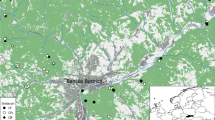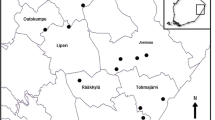Abstract
We compare species richness of bryophytes and vascular plants in Estonian moist forests and mires. The material was collected from two wetland nature reserves. Bryophyte and vascular plant species were recorded in 338 homogeneous stands of approximately 1 ha in nine forest and two mire types. Regional species pools for bryophytes and vascular plants were significantly correlated. The correlations between the species richnesses of bryophytes and vascular plants per stand were positive in all community types. The relative richnesses (local richness divided by the regional species pool size) were similar for bryophyte species and for vascular plant species. This shows that on larger scales, conservation of the communities rich in species of one taxonomic plant group, maintains also the species richness of the other. The minimum number of stands needed for the maintenance of the regional species pool of typical species for the every community type was calculated using the species richness accumulation curves. Less stands are needed to maintain the bryophyte species pools (300–5300 for bryophytes and 400–35 000 for vascular plants).
Similar content being viewed by others
References
Ader A and Tammur E (1997) Alam-Pedja looduskaitseala [Alam-Pedja Nature Reserve]. Tallinna Raamatutrükikoda, Tallinn, Estonia
Allilender K (1999) Soode maa [Land of mires]. Eesti Loodus 10: 423–428
Aude E and Lawesson JE (1998) Vegetation in Danish beech forests: the importance of soil, microclimate and management factors, evaluated by variation partitioning. Plant Ecology 134: 53–65
Dony JG (1977) Species-area relationships in an area of intermediate size. Journal of Ecology 65: 475–484
Dupré C (2000) How to determine a regional species pool: a study in two Swedish regions. Oikos 89: 128–136
Eesti NSV floora I-XI [Flora of the Estonian S.S.R.] (1953–1984) Valgus, Tallinn, Estonia
Eriksson O (1993) The species-pool hypothesis and plant community diversity. Oikos 68: 371–374
Fischer M and Stöcklin J (1997) Local extinctions of plants in remnants of extensively used calcareous grasslands 1950–1985. Conservation Biology 11: 727–737
Giplin ME and Soulé ME (1986) Minimum viable populations: processes of species extinction. In: Soulé ME (ed) Conservation Biology: The Science of Scarcity and Diversity, pp 19–34. Sinauer Associates, Sunderland, Massachusetts
Glaser PH, Janssens JA and Siegel DI (1990) The response of vegetation to chemical and hydrological gradients in the Lost River peatland, northern Minnesota. Journal of Ecology 78: 1021–1048
Gough LG, Grace JB and Taylor KL (1994) The relationship between species richness and community biomass: the importance of environmental variables. Oikos 70: 271–279
Gould WA and Walker MD (1999) Plant communities and landscape diversity along a Canadian Arctic river. Journal of Vegetation Science 10: 537–548
Hallingbäck T (1995) The practice of bryophyte conservation. Cryptogamica Helvetica 18: 119–126
Hanski IA and Gilpin ME (eds) (1997) Metapopulation Biology. Academic Press, San Diego, California
Huston MA (1999) Local processes and regional patterns: appropriate scales for understanding variation in the diversity of plants and animals. Oikos 86: 393–401
Ingerpuu N and Vellak K (1995) The distribution and some ecological characteristics of Estonian rare bryophytes. Arctoa 5: 143–148
Ingerpuu N, Kalda A, Kannukene L, Krall H, Leis M and Vellak K (1994) List of the Estonian bryophytes. Abiks Loodusevaatlejale 94: 1–175
Ingerpuu N, Kull K and Vellak K (1998) Bryophyte vegetation in a woodland meadow: relationships with phanerogam diversity and responses to fertilisation. Plant Ecology 134: 163–171
Ilomets M (1998) Biological diversity of Estonian mires. In: Külvik M and Tambets J (eds) Eesti bioloogilise mitmekesisuse ülevaate (country study) materjale, pp 131–147. EPMÑ Keskkonnakaitse Instituut, Tallinn-Tartu, Estonia
Karoles K (1995) Eesti metsad ja metsasus [Estonian Forests and Their Area]. Eesti Riiklik Metsaamet, Tallinn, Estonia
Kukk T (1999) Eesti taimestik [Vascular Plant Flora of Estonia]. Teaduste Akadeemia Kirjastus, Tartu-Tallinn, Estonia
Kuusk V (1975) Taimede välimääraja [Field Key-Book of Plants]. Valgus, Tallinn, Estonia
Kuusk V, Tabaka L and Jankevičenė (1996) Flora of the Baltic Countries II. Eesti Loodusfoto, Tartu, Estonia
Laasimer L, Kuusk V, Tabaka L and Lekavičius A (1993) Flora of the Baltic Countries I. Eesti Loodusfoto, Tartu, Estonia
Lawton J (1996) Patterns in ecology. Oikos 75: 145–147
Leht M (ed) (1999) Eesti taimede määraja [Key-Book of Estonian Plants]. EPMÑ ZBI, Eesti Loodusfoto, Tartu, Estonia
Lõhmus E (1984) Eesti metsakasvukohatüübid [Forest Site Types of Estonia]. ENSV Agrotööstuskoondise Info-ja Juurutusvalitsus, Tallinn, Estonia
Masing V (1975) Mire Typology of the Estonian S.S.R. In: Laasimer L (ed) Some Aspects of the Botanical Research in the Estonian S.S.R., pp 123–136. Publications Advisory Committee of the Academy of Sciences of the Estonian S.S.R., Tartu, Estonia
McGuinness KA (1984) Equations and explanations in the study of species-area curves. Biological Review 59: 423–440
Meffe GK and Carroll CR (eds) (1994) Principles of conservation biology. Sinauer Association, Sunderland, Massachusetts
Miller RI and Wiegert RG (1989) Documenting completeness, species-area relations and the species-abundance distribution of a regional flora. Ecology 70: 16–22
Navid D (1994) A threatened habitat: wetlands. In: Bennet G (ed) Conserving Europe's Natural Heritage: Towards a European Ecological Network, pp 55–60. Graham & Trotman, London
Noss RF and Csuti B (1994) Habitat fragmentation. In: Meffe GK and Carroll CR (eds) Principles of Conservation Biology, pp 237–264. Sinauer Association, Sunderland, Massachusetts
Orru M, Shirokova M and Veldre M (1992) Eesti turbavarud [Estonian Peat Resources]. Eesti Geoloogia Keskus, Tallinn, Estonia
Paal J (1998) Rare and threatened plant communities of Estonia. Biodiversity and Conservation 7: 1027–1049
Pärtel M and Zobel M (1995) Small-scale dynamics and species richness in successional alvar plant communities. Ecography 18: 83–90
Pärtel M and Zobel M (1999) Small-scale plant species richness in calcareous grasslands determined by the species pool, community age and shoot density. Ecography 22: 153–159
Pärtel M, Zobel M, Zobel K and van der Maarel E (1996) The species pool and its relation to species richness: evidence from Estonian plant communities. Oikos 75: 111–117
Pärtel M, Kalamees R, Zobel M and Rosén E (1998) Restoration of species-rich limestone grassland communities from overgrown land: the importance of propagule availability. Ecological Engineering 10: 275–286
Pärtel M, Kalamees R, Zobel M and Rosén E (1999) Alvar grasslands in Estonia: variation in species composition and community structure. Journal of Vegetation Science 10: 561–570
Rabotnov TA (1987) Eksperimentalnaja fitotsenologija [Experimental Phytocoenology]. Moscow State University, Moscow
Rey Benayas JM (1995) Patterns of diversity in the strata of boreal montane forest in British Columbia. Journal of Vegetation Science 6: 95–98
Rosenzweig ML (1999) Heeding the warning in biodiversity's basic law. Science 284: 276–277
Sansen U and Koedam N (1996) Use of sod cutting for restoration of wet heathlands: revegetation and establishment of typical species in relation to soil conditions. Journal of Vegetation Science 7: 483–486
Såstad S and Moen A (1995) Classification of mire localities and mire species in central Norway by vegetation regions, Ellenberg species indicator values and climatic data. Gunneria 70: 177–188
Sjörs H (1963) Amphi-atlantic zonation, nemoral to arctic. In: Löve A and Löve D (eds) North Atlantic Biota and Their History. Pergamon Press, New York
Sætersdal M (1994) Rarity and species/area relationships of vascular plants in deciduous woods, western Norway-applications to nature reserve selection. Ecography 17: 23–38
Tangney RS, Wilson JB and Mark AF (1990) Bryophyte island biogeography: a study in Lake Manapouri, New Zealand. Oikos 59: 21–26
Taylor DR, Aarssen L and Loehle C (1990) On the relationship between r/K selection and environment carrying capacity: a new habitat templet for plant life history strategies. Oikos 58: 239–250
Thompson K, Gaston KJ and Band SR (1999) Range size, dispersal and niche breadth in the herbaceous flora of central England. Journal of Ecology 87: 150–155
Varblane A (1998) Ñlevaade Eesti metsasuse ja metsakasutuse ajaloost [Survey of the Estonian forest area and management history]. In: Külvik M and Tambets J (eds) Eesti bioloogilise mitmekesisuse ülevaate (country study) materjale, pp 109–113. EPMÑ Keskkonnakaitse instituut. Tallinn-Tartu, Estonia
Vellak K and Paal J (1999) Diversity of bryophyte vegetation in some forest types in Estonia: a comparison of old unmanaged and managed forests. Biodiversity and Conservation 8: 1595–1620
Vitt DH, Li Y and Belland RJ (1995) Patterns of Bryophyte Diversity in Peatlands of Continental Western Canada. The Bryologist 98(2): 218–227
Whittaker RH (1972) Evolution and management of species diversity. Taxon 21: 213–251
Wilson JB and Sykes MT (1988) Some tests for niche limitation by examination of species diversity in the Dunedin area, New Zealand. New Zealand Journal of Botany 26: 237–244
Zobel M (1993) Changes in pine forest communities after clear-cutting: a comparison of two edaphic gradients. Annales Botanici Fennici 30: 131–137
Zobel M (1997) The relative role of species pools in determining plant species richness: an alternative explanation of species coexistence? Trends in Ecology and Evolution 12: 266–269
Zobel K and Liira J (1997) A scale-independent approach to the richness vs biomass relationship in groundlayer plant communities. Oikos 80: 325–332
Zobel M, Suurkask M, Rosén E and Pärtel M (1996) The dynamics of species richness in an experimentally restored calcareous grassland. Journal of Vegetation Science 7: 203–210
Zobel M, van der Maarel E and Dupré C (1998) Species pool: the concept, its determination and significance for community restoration. Applied Vegetation Science 1: 55–66
Author information
Authors and Affiliations
Rights and permissions
About this article
Cite this article
Ingerpuu, N., Vellak, K., Kukk, T. et al. Bryophyte and vascular plant species richness in boreo-nemoral moist forests and mires. Biodiversity and Conservation 10, 2153–2166 (2001). https://doi.org/10.1023/A:1013141609742
Issue Date:
DOI: https://doi.org/10.1023/A:1013141609742




